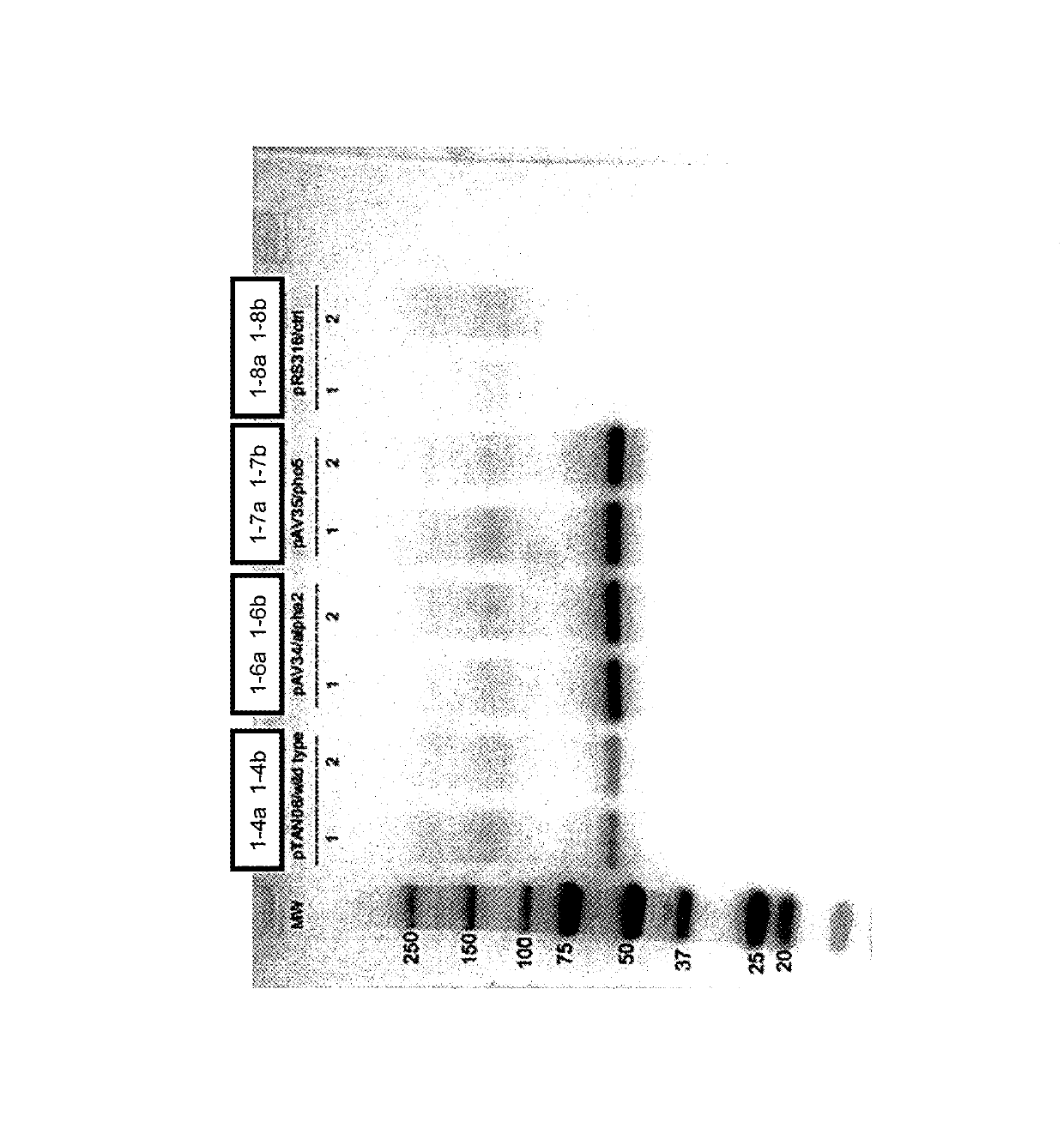Modified glucoamylase enzymes and yeast strains having enhanced bioproduct production
a technology of glucoamylase and modified glucoamylase, which is applied in the field of modified glucoamylase enzymes and yeast strains having enhanced bioproduct production, can solve the problems of increasing ethanol yield, challenging the growth of microorganisms, and affecting cell growth, so as to improve the nutritional content of a feed composition
- Summary
- Abstract
- Description
- Claims
- Application Information
AI Technical Summary
Benefits of technology
Problems solved by technology
Method used
Image
Examples
example 1
Generation of Amylolytic Saccharomyces cerevisiae Strains
Strain 1-3: ura3ΔSaccharomyces cerevisiae Base Strain
[0122]Strain 1 is transformed with SEQ ID NO 1 (pAV18). SEQ ID NO 1 contains the following elements: i) an expression cassette for a mutant version of a 3-deoxy-D-arabino-heptulosonate-7-phosphate (DAHP) synthase gene from Saccharomyces cerevisiae (ARO4-OFP) corresponding to nucleotides 479-2647; ii) loxP sequence corresponding to nucleotides 445-478 and 2648-2681, and iii) flanking DNA for targeted chromosomal integration into integration locus A (URA3) where nucleotides 1-436 correspond to the URA3 5′ flanking region and nucleotides 2691-3182 correspond to the URA3 3′ flanking region. Transformants are selected on synthetic complete medium containing 3.5 g / L of p-fluorophenylalanine, and 1 g / L L-tyrosine (ScD-PFP). Resulting transformants are streaked for single colony isolation on ScD-PFP. A single colony is selected. Correct integration of SEQ ID NO: 1 into one allele of...
example 2
Evaluation of Amylolytic Saccharomyces cerevisaie Strains in Simultaneous Saccharification and Fermentation Shake Flask Assays
Shake Flask Evaluation Using Partially Hydrolyzed Corn Starch (AV_2014-08-20, Changing the Secretion Signal of the Sf GA)
[0132]A subset of strains listed in Table 3 are streaked out on a ScD-Ura plate and incubated at 30° C. until single colonies are visible (1-2 days). Cells from the ScD-Ura plate are scraped into sterile shake flask medium and the optical density (OD600) is measured. Optical density is measured at wavelength of 600 nm with a 1 cm path length using a model Genesys20 spectrophotometer (Thermo Scientific).
[0133]A shake flask is inoculated with the cell slurry to reach an initial OD600 of 0.1-0.3. Immediately prior to inoculating, 50 mL of shake flask medium is added to a 250 mL non-baffled shake flask (Corning 4995-250) fitted with a screw cap containing a gas-permeable seal (corning 1395-45LTMC) The shake flask medium consists of 850 g partia...
example 3
Enzyme Production by Amylolytic Saccharomyces cerevisaie Strains
Shake Flask Evaluation Using Raffinose Grown Cells to Evaluate Enzyme Production
[0137]A subset of strains listed in Table 3 are streaked out on a ScD-Ura plate and incubated at 30° C. until single colonies are visible (1-2 days). Cells from the ScD-Ura plate are scraped into sterile shake flask medium and the optical density (OD600) is measured. Optical density is measured at wavelength of 600 nm with a 1 cm path length using a model Genesys20 spectrophotometer (Thermo Scientific).
[0138]A shake flask is inoculated with the cell slurry to reach an initial OD600 of 0.1-0.3. Immediately prior to inoculating, 100 mL of shake flask medium is added to a 500 mL baffled shake flask. The shake flask medium consists of 5% Raffinose (Sigma R0250), 6.7 g Yeast Nitrogen Base (Difco 291940), and 1.9 g synthetic complete amino acid dropout mix (MP Biomedicals 4410-622).
[0139]The inoculated flask is incubated at 30° C. with shaking in ...
PUM
 Login to View More
Login to View More Abstract
Description
Claims
Application Information
 Login to View More
Login to View More - R&D
- Intellectual Property
- Life Sciences
- Materials
- Tech Scout
- Unparalleled Data Quality
- Higher Quality Content
- 60% Fewer Hallucinations
Browse by: Latest US Patents, China's latest patents, Technical Efficacy Thesaurus, Application Domain, Technology Topic, Popular Technical Reports.
© 2025 PatSnap. All rights reserved.Legal|Privacy policy|Modern Slavery Act Transparency Statement|Sitemap|About US| Contact US: help@patsnap.com

